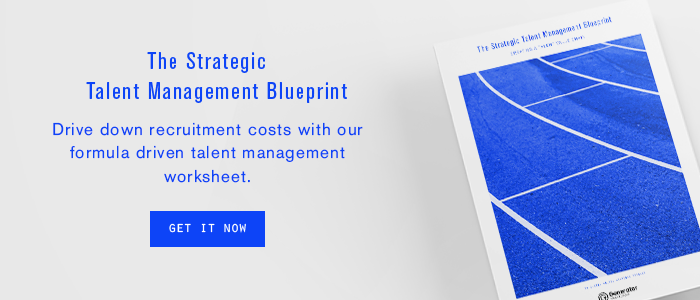15th December 2017
6 essential steps for building a talent pipeline
People are crucial to business growth and success. However, many businesses have a reactive approach to recruiting talent, waiting for an employee to resign before searching for a replacement. This lack of proactive recruitment can compromise your existing team and limit company growth.
No matter which industry you’re in, it’s critical to have a talent pipeline framework in place to attract the right people to support your business. Read on for the six essential steps of building and optimising a talent pipeline.
What is a talent pipeline?
A talent pipeline is an evolving set of people your company may want to hire in the future, either as replacements for critical positions that currently exist (such as executive positions or team leads), or for new roles that may open up within the business.
Building a pipeline involves proactively developing long-term relationships with potential candidates who align with your company’s talent needs, both now and in the future. You’ll need to switch your HR plan from a passive model of recruitment to one where your team is actively seeking the next generation of talent.
How to build a talent pipeline model: 6 steps
1. Plan recruitment according to business strategy.
To build an effective talent pipeline model it’s essential that HR teams understand a company’s strategic direction, both in terms of current needs and plans for growth. Before building a recruitment plan understand which roles are critical to reaching your business goals, and gain visibility on any future growth and expansion plans, or planned projects.
From this point analyse both the future needs of your business and the key roles that will aid in reaching these goals – this will help you prioritise where to focus your hiring efforts.
At the same time, conduct a ‘what if’ analysis to determine what would happen if key team members leave. This reveals any gaps in your current talent pipeline. Finally, leverage talent pipeline metrics to help understand the success of your current talent pipeline plans, and identify areas of improvement.
These can include sources of hire, turnover rate by department, open jobs vs. filled positions, time to hire, and the offer-to-acceptance ratio. For example, if you find good candidates but your offer-to-acceptance ratio is low, you may need to work on your package offering or employer brand.
2. Attract the right talent.
Attracting the right talent to your business is crucial. Many businesses rely on a push strategy for recruitment, by listing roles on job boards or actively contacting talent on LinkedIn. But attracting the right people through a pull strategy reduces the time your team’s need to spend actively finding talent to fill your pipeline. Here, developing your employer brand is key.
Your employer brand describes both your company’s values, culture, and experience – it should speak to the type of talent you’re looking for, and encourage those people to self-select you as a target employer for their next career step. You can also apply for employer awards (such as the Best Places to Work) to help build your brand.
3. Find the right talent.
No matter which industry you’re in, your talent pipeline should contain a mix of both internal and external candidates. Start by building a talent pool of internal candidates which have the potential to succeed any key roles or take on new roles as your company grows, and identify any key competences or skills that need to be developed to ensure they’re ready for the next step. This is best done through an annual talent review process across your organisation.
For external candidates, it’s important to have a consistent approach to identifying the right people to your talent pool – even if they are not actively searching for a new role. There are plenty of places to find talent to add to your pool, including:
- Networking events: Use these as quasi-interview opportunities to assess whether talent could be suitable for any future roles that open up in your business.
- LinkedIn: Join industry groups or other networks where you could find talent that matches your company’s values and needs, and add any interesting candidates you meet at networking events. Be active to keep potential talent engaged – push company news on your newsfeed, congratulate them on any career milestones, or wish them happy birthday – it all counts down the line.
- Dedicated recruitment campaigns: From graduate programs to roadshows, these campaigns can help supercharge your talent recruitment pool with quality candidates.
- Leverage your existing contacts: Build employee referral programs and identify any internal influencers who could help champion your company culture and fuel recruitment efforts. Encourage team members to share any campaigns on their own channels, and incentivise those who refer high-quality talent.
4. Assess talent.
After you’ve built your talent pool, the next step in your talent pipeline model is assessment. Consider how you’ll qualify potential candidates to assess their potential to fill key positions. Create assessment criteria based on qualitative and quantitative needs. Consider the following questions:
- What skills and competencies will your candidates need to have to succeed?
- Which of these can you help them develop for a future role?
- What challenges will they meet in the future?
- What experience will they need to have to overcome these challenges?
- What knowledge do they need to have of your company?
Work with your hiring committee and top executives to develop a list of criteria, and refer back to this when assessing candidates in your talent pool.
5. Focus on developing your talent.
Building your talent model pipeline isn’t just about finding the right people – it’s about the ongoing development of your teams to put them in the best position possible for success.
After you’ve identified assessment criteria, you can build a dedicated program that address any skill gaps and provides ongoing training opportunities for development. This could include internal and external coaching, cross-functional experiences and internal assignment opportunities both nationally and globally.
Your business can have multiple programs, such as regional or global leadership development programs, or dedicated executive training programs. Regardless, ensure you develop a brand and identity for your program, and communicate it widely so all team members are aware of the initiative. This program also serves as a great selling tool to attract future talent to your business.
6. Monitor talent and outcomes and adjust accordingly.
This is where your talent pipeline metrics come into place, helping to evaluate the effectiveness of your talent pipeline model and identify future areas of development. Set KPIs for different areas, and monitor outcomes to measure success.
For example, the effectiveness of your employer brand can be measured by the number of unsolicited expressions of interest you receive for roles, while development programs can be measured by employee turnover rates. Review your outcomes half-yearly or annually, and adjust your model accordingly to ensure your talent pipeline model continues to serve your business needs.
Next steps
To kickstart your talent pipeline, download our interactive Strategic Talent Management Blueprint. It’s designed to help you drive down recruitment costs by developing a proactive, data-based talent management strategy. Get your copy by clicking the image below.
Categories: Acquiring Talent




